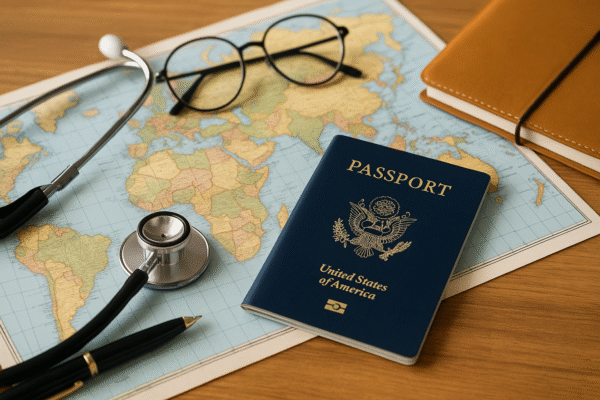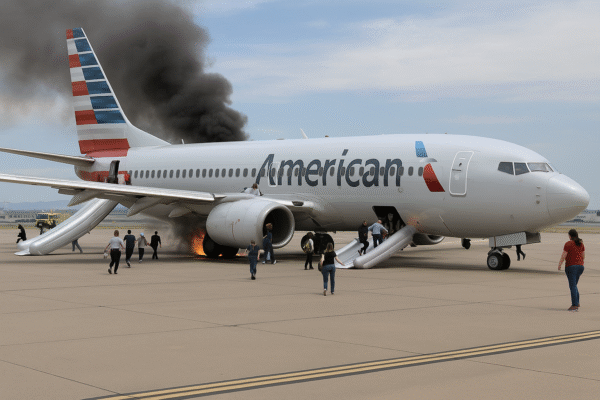In a harrowing aviation incident on July 26, 2025, American Airlines Flight 3023, a Boeing 737 Max 8 bound for Miami, was forced to abort takeoff at Denver International Airport (DEN) after a brake fire and tire blowout triggered an emergency evacuation of all 179 people onboard. The event is now under investigation by the Federal Aviation Administration (FAA) and has renewed public concern over aircraft safety standards in the U.S.
🔥 Brake Fire Sparks Mid-Runway Chaos
The flight, operated by American Airlines, was accelerating down the runway when it reached approximately 150 mph—seconds away from liftoff—when passengers reported hearing a loud boom and seeing smoke and flames erupting from the landing gear. According to official reports, the cause was linked to blown tires and an overheated brake system, which ignited a fire underneath the aircraft.
Passengers quickly realized the severity of the situation. “We were just about to lift off when we heard a loud boom,” recalled passenger Mark Tsurkis. “Flames and smoke started coming from under the wing, and then we stopped abruptly. People started yelling, and within seconds, the evacuation began.”
🧯 Swift Evacuation and Emergency Response
The crew deployed emergency slides, and all passengers and crew safely evacuated the aircraft onto the tarmac. Firefighters from the Denver Fire Department arrived rapidly and extinguished the blaze within minutes. One passenger sustained minor injuries but was treated on-site.
American Airlines coordinated with airport authorities to shuttle passengers back to the terminal, and later arranged an alternate flight to Miami for affected travelers.
🕵️ FAA Investigation Underway
The FAA immediately launched an investigation into the landing gear malfunction, focusing on whether mechanical failure or maintenance issues led to the dangerous fire. The Boeing 737 Max 8 in question has been removed from service pending inspection. FAA representatives have stated that the incident will be included in ongoing reviews of aircraft safety and airline maintenance protocols.
The incident comes as part of a troubling series of aviation emergencies. Just one day earlier, a Southwest Airlines flight was forced into an emergency descent to avoid a mid-air collision, sparking increased scrutiny over flight operations nationwide.
✈️ Growing Focus on Boeing 737 Max Safety
The Boeing 737 Max series has been under international scrutiny since its global grounding in 2019 due to safety flaws. Though recertified, incidents like Flight 3023’s brake fire raise renewed questions about the aircraft’s performance under stress. In response, aviation experts are calling for enhanced pre-flight inspections and stricter oversight of brake and tire systems, especially during peak summer travel seasons when runway temperatures soar.
👥 Passenger Accounts and Online Reactions
Multiple passengers took to social media to share footage and testimonials, with videos showing dense smoke streaming from the aircraft’s underside and passengers disembarking in visible distress. Eyewitness accounts emphasized the professionalism of the crew, who were praised for managing the evacuation smoothly under high-pressure conditions.
Passenger Kaitlyn Brooks posted on X (formerly Twitter), “Terrifying moment on @AmericanAir Flight 3023 today. Huge boom. Smoke. Panic. But major respect to the crew who got us out safely.”
🛫 Airline and Regulatory Response
American Airlines issued a statement shortly after the incident, confirming that all passengers were safe and the flight crew followed standard emergency procedures. The airline also emphasized its commitment to safety and is cooperating fully with the FAA investigation.
Meanwhile, the FAA has pledged to release a preliminary report within the next 30 days, with a full technical assessment to follow. According to the agency’s official statement, “All aspects of the mechanical systems, including tire pressure, brake assembly, and temperature thresholds, will be thoroughly examined.”
🧳 What Travelers Should Know
This incident is a strong reminder for travelers to:
- Pay attention to pre-flight safety briefings.
- Know the location of emergency exits.
- Stay calm and follow crew instructions during emergencies.
The FAA also encourages passengers to report any safety concerns or anomalies they observe during flights via the FAA Aviation Safety Hotline.
📌 Conclusion: FAA Probe into American Airlines Incident May Prompt New Safety Measures
The emergency evacuation of Flight 3023 has placed American Airlines and the FAA under a renewed spotlight. While no lives were lost, the seriousness of the incident and its timing—during a period of heightened air travel—has raised urgent questions about maintenance, safety procedures, and aviation readiness.
As the FAA investigation progresses, it’s likely that recommendations for stricter aircraft inspections, especially on high-frequency domestic routes, will follow. The Boeing 737 Max 8’s brake system and landing gear design may also come under more technical scrutiny.
For now, American travelers are advised to stay informed, be aware of emergency protocols, and follow developments as regulators and airlines work to ensure safer skies.
For more travel news like this, keep reading Global Travel Wire



















